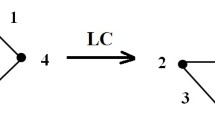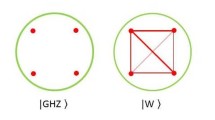Abstract
We use concurrence to study bipartite entanglement, Meyer-Wallach measure and its generalizations to study multi-partite entanglement and MABK and SASA inequalities to study the non-local properties of the 4-qubit entangled graph states, quantitatively. Then, we present 3 classifications, each one in accordance with one of the aforementioned properties. We also observe that the classification according to multipartite entanglement does exactly coincide with that according to nonlocal properties, but does not match with that according to bipartite entanglement. This observation signifies the fact that non-locality and multipartite entanglement enjoy the same basic underlying principles, while bipartite entanglement may not reveal the non-locality issue in its entirety.

Similar content being viewed by others
References
Hein, M., Dur, W., Eisert, J., Raussendorf, R., Van den Nest, M., Briegel, H.J.: Entanglement in graph states and its applications. Proc. Internat. School Phys. Enrico Fermi. Quantum Computers, Algorithms and Chaos. 162, 115 (2006)
Severini, S.: Two-colorable graph states with maximal Schmidt measure. Phys. Lett. A 356, 99 (2006)
Hein, M., Eisert, J., Eisert, H., Briegel, J.: Multiparty entanglement in graph states. Phys. Rev. A 69, 062311 (2004)
Salimi, S., Karami, D., Salimi, E.: Investigation of preparation up to six and n-atom graph states. Int. J. Theor. Phys. 51, 2031 (2012)
Schlingemann, D., Werner, R.F.: Quantum error-correcting codes associated with graphs. Phy. Rev. A 65, 012308 (2001)
Gottesman, D.: A class of quantum error-correcting codes saturating the quantum Hamming bound. Phy. Rev. A 54, 1862 (1996)
Briegel, H.J., Raussendorf, R.: Persistent entanglement in arrays of interacting particles. Phys. Rev. Lett. 86, 910 (2001)
Grassl, M., Klappenecker, A., Rotteler, M.: Graphs, quadratic forms, and quantum codes. arXiv:0703112v1 (2007)
Schlingemann, D.: Quantum error correcting codes and one-way quantum computing towards a quantum memory. arXiv:quant-ph/0308022v1 (2003)
Huang, W., Wei, Z.: Efficient one-way quantum computations for quantum error correction. J. Phys. A: Math. Theor. 42, 295301 (2009)
Nielsen, M.A., Chuang, I.L.: Quantum Computation and Quantum Information. Cambridge University Press, Cambridge (2010)
Raussendorf, R., Briegel, H.J.: Quantum computing via measurements only. Phys. Rev. Lett. 86, 5188 (2000)
Gottesman, D.: Stabilizer codes and quantum error correction. arXiv:9705052v1[quant-ph] (1997)
Van den Nest, M., Dur, W., Miyake, A., Briegel, H.J.: Fundamentals of universality in one-way quantum computation. New J. Phys. 9, 204 (2007)
Campbell, E.T., Fitzsimons, J.: An introduction to one-way quantum computing in distributed architectures. Int. J. Quantum Inf. 8, 219 (2010)
Lee, S.M., Park, H.S., Cho, J., Kang, Y., Lee, J.Y., Kim, H., Lee, D.H., Choi, S.K.: Experimental realization of a four-photon seven-qubit graph state for one-way quantum computation. Opt. Express. 70, 6915 (2012)
Browne, D., Briegel, H.: One-way quantum computation. arXiv:0603226v2[quant-ph] (2006)
Nielsen, M.A.: Cluster-state quantum computation. Rep. Math. Phys. 57, 147 (2006)
Bell, B.A., Tame, M.S., Clark, A.S., Nock, R.W., Wadsworth, W.J., Rarity, J.G.: Experimental characterization of universal one-way quantum computing. New J. Phys. 15, 053030 (2013)
Dur, W., Aschauer, H., Briegel, H.J.: Multiparticle entanglement purification for graph states. Phys. Rev. Lett. 91, 107903 (2003)
Hajdusek, M., Murao, M.: Direct evaluation of pure graph state entanglement. New J. Phys. 15, 013039 (2013)
Plesch, M., Buzek, V.: Entangled graphs: bipartite entanglement in multiqubit systems. Phys. Rev. A 67, 012322 (2003)
Paul, N., Menon, J.V., Karumanchi, S., Muralidharan, S., Panigrahi, P.K.: Quantum tasks using six qubit cluster states. Quant. Inf. Process. 10, 619 (2011)
Li, D. C. h., Cao, Z.L.: Teleportation of two-particle entangled state via cluster state. Theor. Phys. 47, 464 (2007)
Guhne, O., Toth, G., Hyllus, P., Briegel, H.J.: Bell inequalities for graph states. Phys. Rev. Lett. 95, 120405 (2005)
Scarani, V., Acin, A., Schenck, E., Aspelmeyer, M.: Nonlocality of cluster states of qubits. Phys. Rev. A 71, 042325 (2005)
Ceccarelli, R., Vallone, G., Martini, F.D., Mataloni, P., Cabello, A.: Experimental entanglement and nonlocality of a two-photon six-qubit cluster state. Phys. Rev. Lett. 103, 160401 (2009)
Wootters, W.: Entangled chains. arXiv:0001114[quant-ph] (2000)
Dur, W.: Multi-partite entanglement that is robust against disposal of particles. Phys. Rev. A 63, 020303 (2001)
Koashi, M., Buzek, V., Imoto, N.: Entangled webs. Phys. Rev. A 62, 050302(R) (2000)
Akhtarshenas, S.J., GharahiGhahi, M.: Entangled graphs: a classification of four-qubit entanglement. arXiv:1003.2762v1[qunt-ph] (2010)
Love, P.J., Van den Brink, A.M., Smirnov, A. Y., Amin, M.H.S., Grajcar, M., Ilichev, E., Izmalkov, A., Zagoskin, A.M.: A characterization of global entanglement. Quantum. Inf. Process. 6, 187 (2007)
Meyer, D.A., Wallach, N.R.: Global entanglement in multiparticle systems. J. Math. Phys. 43, 4273 (2002)
Scott, A.J.: Multi-partite entanglement quantum-error-correcting codes and entangling power of quantum evolutions. Phys. Rev. A 69, 052330 (2004)
Belinskii, A.V., Klyshko, D.N.: Interference of light and Bell’s theorem. Phys. Ups 36, 653 (1993)
Zukowski, M.: Bell theorem involving all settings of measuring apparatus. Phys. Lett. A, 177 (1993)
Mermin, N.D.: Extreme quantum entanglement in a superposition of macroscopically distinct states. Phys. Rev. Lett. 65, 1838 (1990)
Ardehali, M.: Bell inequalities with a magnitude of violation that grows exponentially with the number of particles. Phys. Rev. A 46, 5375 (1992)
Horodecki, M., Horodecki, P., Horodecki, R.: Separability of mixed states: necessary and sufficient conditions. Phys. Lett. A, 223 (1996)
Rai, S., Luthra, J.R.: Negativity and concurrence for two qutrits. arXiv:0507263v1[quant-ph] (2005)
Wootters, W.: Entanglement of formation and concurrence. Quant. Inf. and Comp. 1(1), 27 (2001)
Chunfeng, W. u., Ye, Yeo, Kwek, L.C., Oh, C.H: Quantum nonlocality of four-qubit entangled states. Phys. Rev. A 75, 032332 (2007)
Gisin, N, Bechmann-Pasquinucci, H.: Bell inequality, bell states and maximally entangled states for n qubits. Phys. Lett. A, 246 (1998)
Zukowski, M., Brukner, C.: Bell’s theorem for general N-qubit states. arXiv:0102039v3[quant-ph] (2002)
Author information
Authors and Affiliations
Corresponding author
Appendices
Appendix: 1
Defining
We obtain
Appendix: 2
Rights and permissions
About this article
Cite this article
Assadi, L., Jafarpour, M. Classification of 4-qubit Entangled Graph States According to Bipartite Entanglement, Multipartite Entanglement and Non-local Properties. Int J Theor Phys 55, 4809–4821 (2016). https://doi.org/10.1007/s10773-016-3104-x
Received:
Accepted:
Published:
Issue Date:
DOI: https://doi.org/10.1007/s10773-016-3104-x




